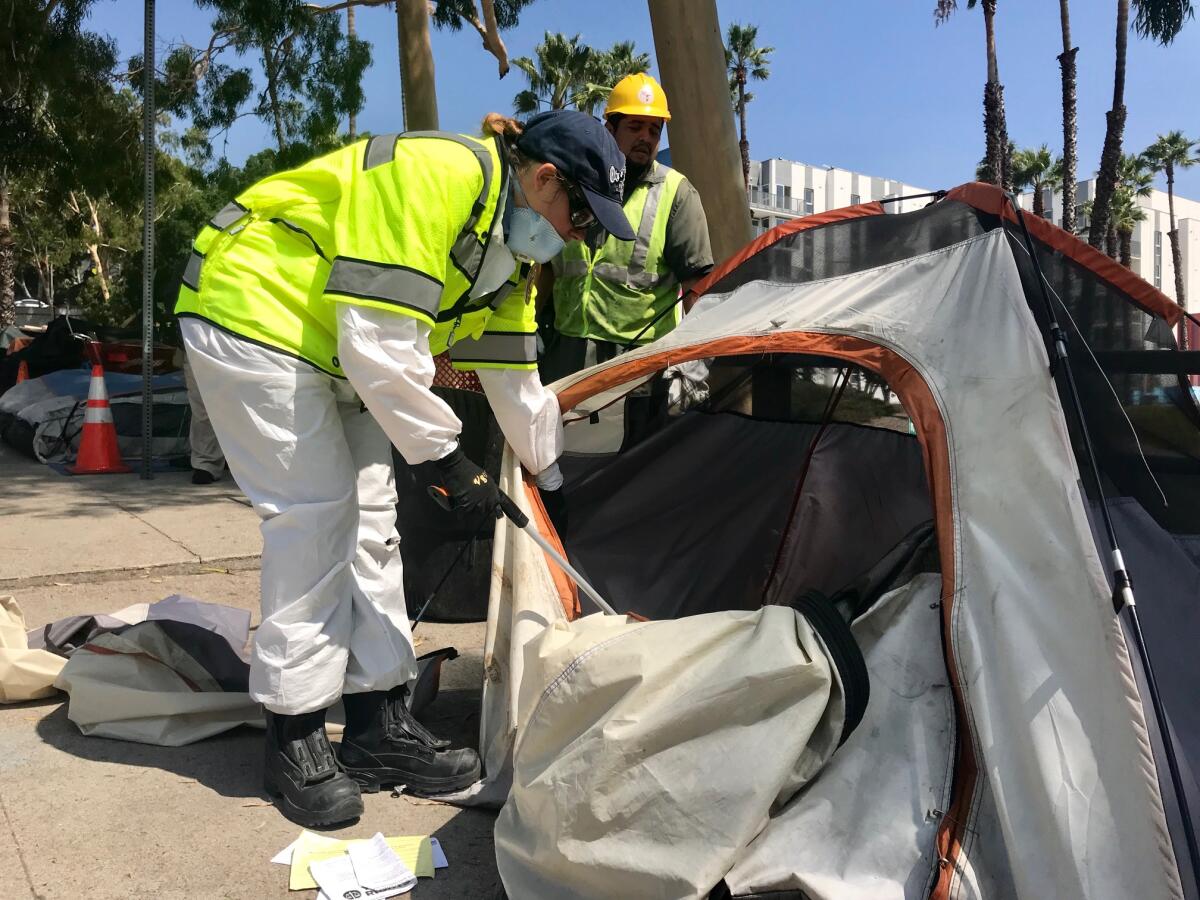The city has a growing mountain of possessions confiscated from homeless people

- Share via
Even if you’re living on the streets, your stuff is your stuff.
You prize it, you guard it, you try to hold onto it.
But it doesn’t always work out the way you’d like.
Your things might be blocking the street, or you might have to leave them unattended while you run an errand or seek medical treatment. In circumstances like that, officials may go in and confiscate your things.
I’ve been wondering what happens to all that stuff, and on Monday, I found out.
On skid row in downtown Los Angeles, a huge storage facility is packed with items owned by homeless people. I dropped by to have a look at what’s in there, but before I fill you in, let me take you out to the streets just east of the downtown halls of power, where a lot of the items came from.

On Cesar Chavez Boulevard, just up from Olvera Street, a city sanitation worker used long-handled grippers to snag a hypodermic needle out of a suitcase. It was Monday morning, and this was one small part of a daily homeless encampment cleanup in Los Angeles. The crew I watched, with seven sanitation workers and three police officers, was one of 20 such teams out scouring the city.
In a region with nearly 60,000 homeless people, more than half of them in L.A., we all wrestle with the magnitude of a social and economic breakdown that has been called one of the great human catastrophes of our time. Big-picture solutions are hard to come by, but after a close-up view of the daily emergency and all the manpower and money that go into managing it, you wish the long-term answers would emerge sooner rather than later.
In June, according to stats provided by L.A. Mayor Eric Garcetti’s office, city sanitation crews completed 894 visits to homeless encampments. The city crews disposed of 3,999 needles and sharp objects and 11,022 pounds of human waste. They collected 1,347 tons of landfill waste, and calculate that about 80% of that was trash that had been illegally dumped, perhaps by haulers or merchants conveniently avoiding fees by using encampments as landfills.
It’s a job that’s never done, and despite the fact that thousands were housed last year and hundreds of millions of dollars spent, the homeless numbers have only grown.
“To me, it’s the biggest crisis we face as a city and as a nation,” said Sal Rosales, an environmental compliance technician from the sanitation department. He wore a mask and protective gear as he searched what appeared to be abandoned tents and belongings on sidewalks east of downtown Los Angeles.
We were standing near a woman I’d seen before — she had a feeding tube and a tracheostomy collar when I met her last month. Rosales said she’d been hospitalized many times, only to return as soon as she could to the tent she called home. Rosales said he’s been working this same area for three months and is still surprised each day by the living conditions and levels of disease on display.

Rosales and a colleague, Carolyn Cook, came upon a tent whose owner had left a note asking them not to confiscate his belongings. But the tent had a smear of what looked like blood or feces, which Rosales considered a potential public health hazard. When he and Cook peeked inside, they found clothing, food and three kitchen knives. Assaults are not uncommon around here, nor are efforts at self-defense.
The cleanup crew tossed the tent into a dump truck, confiscated the knives and bagged the clothing for storage, as long as it was not soiled by urine, feces or other contaminants.
“Dealing with people’s personal property gets really personal,” said Rosales. “We realize we could come off as the bad guy, but we have to balance the public health hazard with people’s rights.”
And then there are the rights of residents and merchants to consider, some of whom complain that sidewalks are impassable or storefronts are blocked.
While the crew worked, a man from Democratic Socialists of America videotaped the cleanup on his phone, keeping vigil. The next day, in the same general location, a homeless man told me he thought the cleanup crews sometimes harassed rather than helped people with nowhere else to go — a contention at the center of ongoing disputes over confiscated goods and legal battles about the right to camp in public places if you have no option.
A federal civil rights lawsuit seeks to stop the city from destroying many items that are confiscated on the streets, including tents, sleeping bags, medication and other necessary items. The crews, however, say they are very careful about what they take.
On Tuesday, those who were camped on the side of the street where the tent had been tossed were ordered to move across the street, making way for a more comprehensive spray cleaning of the sidewalk. After which, they’d move back. It’s a well-choreographed daily drama, an endless shuffle.
Jamie Keene, one of Mayor Garcetti’s top homeless services deputies, said a new strategy will kick in this October. The number of teams like the one I hung out with will go from 20 to 30, they’ll add social workers to each crew, and there will be a greater emphasis on linking people with services that get them off the streets and into shelter or housing.
When Rosales and Cook finished packing the goods from the tent I watched them clear out, Rosales posted a note at the site, informing the owner who to call if he wanted his belongings (or at least those not sent to landfill) returned. The bag was tossed onto a truck for transport to the storage facility on skid row.
Skid row actually has two storage facilities. One is for homeless people who want to voluntarily store their goods. It’s called The Bin, and it’s run by Chrysalis, a nonprofit that offers services to homeless and low-income people. The Bin’s manager, Jillian Smith, showed me a room about the size of a football field, lined with 1,464 green, blue and black trash bins filled with possessions.
About 400 to 500 people drop by daily to retrieve or add to their possessions. Julio Cesar, 50, told me he lives outdoors at Fourth and San Pedro, where he’s been robbed and clubbed with baseball bats. So he prefers to be without items someone might mug him for, and he drops by The Bin a few times weekly for clean clothes.
“I wait for an opportunity to work,” he said, telling me he’s worked as a day laborer and in restaurants.
The bag of goods from the tent was brought to The Bin for processing, then it would be transported two blocks away to another storage facility. At that location, confiscated items are stacked on shelves, floor to ceiling, most of it in bulging, transparent plastic bags stuffed with clothing, shoes, blankets – the stuff of an ordinary life.
Bicycles lean against each other on the floor. I saw an electric table saw, a walker, a stroller, lots of sleeping bags, blankets, suitcases, a box of crayons, a DVD (“Much Ado About Nothing”), and a surfboard.
At this and six other storage facilities in Los Angeles, items are dumped if no one claims them within 90 days. According to the latest stats, about two-thirds of the stored goods are reclaimed before being destroyed.
I didn’t see any big-ticket items in storage, but price and value are entirely different things. And when you’ve already lost just about everything else, maybe the last holdings become the treasures you can’t let go of.
More to Read
Sign up for Essential California
The most important California stories and recommendations in your inbox every morning.
You may occasionally receive promotional content from the Los Angeles Times.













